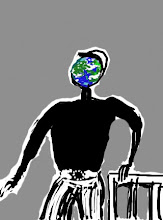So, here comes Roger Penrose, Cycles of Time (2010). Here’s David Kaiser’s LRB summary of Penrose:
During the earliest moment of one aeon, the universe would be hot and dense, as our observable was right after the big bang. When temperatures are much greater than particles’ masses, particles behave as if they had essentially no mass at all: they zip around at nearly the speed of light, just as photons do. That’s critical, because the behaviour of massless particles involves no inherent reference scale—no baseline unit of length or time, no metre stick or calibration clock against which other measures might compare. As far as a photon is concerned time simply does not flow. A spacetime filled with massless particles would have no inherent scales by which to measure length or time. It would be governed, in other words, by conformal geometry: shapes and angles would have meaning, but overall distances would not. Remarkably, the end of an aeon might behave in much the same way. As the universe expands and cools after the beginning of a cycle, the ambient temperature would drop (looking, for observers within that epoch, just as our own big-bang universe does to us). Massive [I guess he means ‘massy’] particles like electrons, protons, hydrogen atoms and all the rest would gradually lose energy; they would no longer zip around as fast as massless photons do. In that regime, length and time and scale would emerge; the symmetries of conformal geometry would be suppressed. The universe would behave as ours does today. Pockets of dust would clump and, fuelled by the energy of gravitational collapse, ignite into the nuclear reactors we call stars. [LRB 17 Feb 2011, 36-37]A couple of things follow from this, or seem to. One is that the idea that spacetime itself, not only things inside space time, is in motion—expanding and contracting, for instance, and for some of that time ‘moving’ faster than light. Another is that ‘length and time and scale’ belong to a different logic than do ‘shapes and angles’—which seems to us counterintuitive, but is no less true for all that.
So much for the behaviour of the universe after a few tens of billions of years. We know from supernova measurements and WMAP data that our universe will almost certainly never collapse back on itself but continue to expand for ever. So Penrose presses on: what will our universe look like after, say, ten-to-the-hundred years? By that late time nearly all of the extant matter would be likely to have fallen into black holes. Indeed swarms of black holes would have swallowed each other, forming supermassive black holes. But even black holes, it turns out, are not foolproof containers. Stephen Hawking demonstrated 35 years ago that black holes should radiate, slowly but surely emitting energy in the form of low-energy light.I don’t get this, I’ll confess. I always thought Hawking Radiation was generated by particles at the event horizon being split into positive and negative, the former being emitted and the latter falling into the black hole. But if we posit a single supermassive black hole as the end of the material cosmos, what is there outside the black hole (as it were) to be split in this fashion and so radiate out? I’m missing something obvious here, I don’t doubt. Anyhow:
Black holes behave like cosmic rubbish compactors; swallowing up massive detritus and ever so slowly seeping energy back into the cosmos in the form of massless protons. The process might contribute inexorably, until the black holes themselves evaporate. A nearly empty universe would be left, containing virtually nothing but massless particles—a spacetime once again governed by conformal geometry.Penrose’s argument is that this end-point can be ‘stitched’ onto the beginning point; that the metahistory of the cosmos entails a process of ‘falling into’ time for many billions of years, until time itself dissolves form the picture, and the whole thing can start again. I’d like to imagine a civilisation finding a way to thread matter precisely amongst a geometrically counterbalanced network of black holes, and effectively putting an end to this cycle. Unlikely, but possible, surely? I’m also struck by the idea that massy spacetime and massless space might exist in a superposition, a kind of spacetimespace. What happens at the moment of transition? Is it like the weirdness of water becoming ice (in which case, is there a 4⁰ greatest density equivalent?). Very intriguing.

2 comments:
I think the idea is that paired particles are constantly being generated from nothing, and immediately cancelling each other out; the edge of a black hole disrupts the second part of this process.
That's my understanding too. I can see this if black holes are one amongst many features in present-day space time. But Penrose is pondering a time when everything has collapsed into one giant black hole. Won't this mean that there' no where for Hawking radiation to radiate into?
Post a Comment